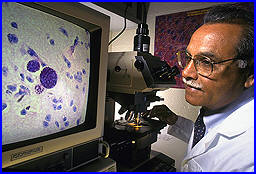



Retail Meat Analyzed for Parasites
US - A recently completed survey of meats for a common microscopic parasite found none in raw beef and poultry and a low level in pork. |
| Microbiologist J.P. Dubey examines Toxoplasma gondii parasites at the ARS Animal Parasitic Disease Laboratory, Beltsville, Md. |
The study focused on the parasite Toxoplasma gondii, which commonly infects animals and humans worldwide, and was conducted by scientists with the U.S. Department of Agriculture (USDA) and the Centers for Disease Control and Prevention (CDC).
The study was led by scientists Dolores E. Hill and Jitender P. Dubey of USDA's Agricultural Research Service (ARS) and was published in The Journal of Parasitology. Hill and Dubey are experts in parasitology research at ARS' Henry A. Wallace Beltsville (Md.) Agricultural Research Center (BARC).
The scientists analyzed samples of retail meat obtained from nearly 700 stores nationwide. More than 6,000 samples—2,000 each of pork, chicken and beef—were purchased from stores in 28 major U.S. geographic areas. Each sample weighed a minimum of 2.2 pounds, for a total of more than 14,000 pounds of meat tested.
None of the raw beef and chicken meat samples contained live T. gondii parasites, based on a controlled analysis. In raw pork from retail meat cases nationwide, the prevalence of live T. gondii parasites was estimated at a low 0.4 percent, or about four per 1,000 samples.
"The survey shows that beef and chicken have negligible amounts of the parasite, while pork has extremely low levels that are effectively eliminated by proper cooking," said microbiologist Mark Jenkins, with ARS' Animal Parasitic Disease Laboratory at BARC.
Besides the consumption of undercooked meat, another route of T. gondii infection is exposure to egglike oocysts in the feces of infected cats. A rodent- or bird-eating cat that has T. gondii in its body expels millions of infectious-stage oocysts of the parasite during a week or two.
The parasite can seriously damage developing fetuses and persons with weakened immune systems, such as those infected with HIV, according to experts. Infants born to mothers who become infected for the first time just before or during pregnancy are at risk of developing severe toxoplasmosis due to T. gondii exposure.
The hardy encapsulated oocysts create the risk of infection when deposited in soil, sand and litter boxes or near farm animal feed. To reduce risk of infection, wash hands well after outdoor activities and after handling raw meat, and don't eat undercooked meat.
ThePoultrySite News Desk








